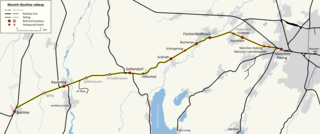
Augsburg is a city in the Bavarian part of Swabia, Germany, around 50 kilometres (31 mi) west of the Bavarian capital Munich. It is a university town and the regional seat of the Regierungsbezirk Swabia with an impressive Altstadt. Augsburg is an urban district and home to the institutions of the Landkreis Augsburg. It is the third-largest city in Bavaria, with a population of 304,000 and 885,000 in its metropolitan area.
Augsburg is a Landkreis (district) in Swabia, Bavaria, Germany. It is bounded by the city of Augsburg and the districts of Aichach-Friedberg, Landsberg, Ostallgäu, Unterallgäu, Günzburg, Dillingen and Donau-Ries. The city of Augsburg is not part of the district, but nonetheless is its administrative seat.
Landsberg am Lech is a Landkreis (district) in Bavaria, Germany. It is bounded by the districts of Aichach-Friedberg, Fürstenfeldbruck, Starnberg, Weilheim-Schongau, Ostallgäu and Augsburg.

Friedberg is a town in the district Aichach-Friedberg, Bavaria, Germany, with some 30,000 inhabitants. It is located next to Augsburg at the river Lech. The town was founded in the 13th century in order to collect a toll from people using the bridge across the Lech.

The Augsburg Eiskanal is an artificial whitewater river in Augsburg, Germany, constructed as the canoe slalom venue for the 1972 Summer Olympics in nearby Munich.

Schwabmünchen is a town in Bavaria in the administrative region of Swabia south of Augsburg in the Augsburg district.

Zschornewitz is a village and a former municipality on the southwestern edge of the Wittenberg district in Saxony-Anhalt, Germany. Since 1 January 2011, it is part of the town Gräfenhainichen. It was part of the administrative community (Verwaltungsgemeinschaft) of Tor zur Dübener Heide. It lies about 4 km west of the former district seat of Gräfenhainichen, right on the border with Saxony.

Krumbach is a town with 13,000 residents in the district Günzburg in Swabia, Bavaria, Germany. It is the second biggest town in the district.

Mering is a municipality in the district Aichach-Friedberg, in Bavaria, Germany. It is located on the river Paar.

Thierhaupten is a market town in south-central Germany in the district of Augsburg (district) in the Swabia administrative region of Bavaria, and is located at the Lech Valley.
At the 1972 Summer Olympics in Munich, seven events in sprint canoe racing were contested, and for the first time at the Olympic Games, four events in slalom canoeing were also contested, at the Augsburg Eiskanal.

The Bavarian Maximilian Railway was as an east–west line built between the Bavarian border with Württemberg at Neu-Ulm in the west via Augsburg, Munich and Rosenheim to the Austrian border at Kufstein and Salzburg in the east as part of the Royal Bavarian State Railways. The Munich–Augsburg section of the line had already been built by the Munich-Augsburg Railway Company and opened in 1840. The line was named after the reigning King of Bavaria from 1848 to 1864 Maximilian II.

The Ingolstadt–Augsburg-Hochzoll railway is a railway that runs for part of its way through the Paar Valley between Augsburg-Hochzoll and Ingolstadt via Friedberg, Dasing, Aichach and Schrobenhausen. This single-tracked, unelectrified main line is 63 km long and has timetable no. KBS 983.

The Bundesstraße 23 is a German federal highway in Bavaria that runs about 59.2 kilometres, from Peiting to the Austrian border near Garmisch-Partenkirchen. This highway (partially), along with the Bundesstraße 17 and Bundesstraße 472 highways, constitute the “German Alpine Road”. Coupled with the Bundesstraße 2 highway, it passes through cities such as Mittenwald, Innsbruck and the Brenner Pass.

Augsburg Haunstetterstraße station is a station south of central Augsburg in the German state of Bavaria. It lies on a railway bridge over Haunstetter Straße, formerly written "Haunstetterstraße", and extends west to the Hochfeld bridge, which has been directly accessible via a staircase from the platform since December 2009. It is classified by Deutsche Bahn as a category 3 station. The station has been considerably remodelled in recent years as part of the upgrading of the Munich–Augsburg railway to have four tracks and is now mainly used to transfer between regional trains and tram lines 2, 3 and special event tram lines 8 and 9.

Augsburg-Hochzoll station is a station in the Hochzoll district east of central Augsburg in the German state of Bavaria. Directly west of the station the Paar Valley Railway separates from the Munich–Augsburg railway running from Augsburg Central Station (Hauptbahnhof). It is classified by Deutsche Bahn as a category 3 station.

The Bundesstraße 10 is a German federal highway. It leads from Eppelborn, near the city of Lebach in Saarland, eastward to Neusäß near Augsburg in Bavaria. The Bundesautobahn 8 mostly runs in parallel to the Bundesstraße 10.

The Bergmannstraße is a street in Munich and lies west of the city center. It leads from Landsberger Straße in the north to Ridlerstraße in the south and is located in the district of Schwanthalerhöhe. The formerly referred to as Sendlinger way road, was named in 1883 after the lawyer, historian and archivist Michael Adam von Bergmann (1733-1783), who was city chief judge starting in 1762 and then became mayor in Munich.

The Bundesstraße 17 is a German federal highway, running some 110 kilometres from Gersthofen to the Austrian border near Füssen, along the Lech river. From north to south; it passes through cities such as Augsburg, Landsberg am Lech, Schongau, Peiting, Steingaden and Schwangau.

The Munich–Buchloe railway is a double-track, electrified main line in Bavaria, Germany. The 60 kilometre-long line runs from Munich Pasing via Geltendorf and Kaufering to Buchloe. Together with the Buchloe–Kempten–Lindau line, it is known as the Allgäubahn. The line is owned and maintained by DB Netz.

















